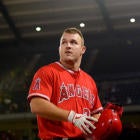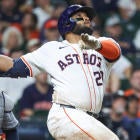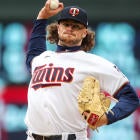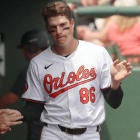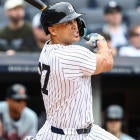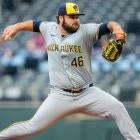Get ready to build a winning team on Draft Day with SportsLine.com's exclusive stats, tools, and projections. Download the Draft Kit with rankings, tiers, auction values, player breakdowns, projections, and more.
With Mike Trout's free agency looming in 2020, the Angels were facing a potential disaster. You can't trade Trout if you're trying to win, but you can't let him walk for nothing.
So, they signed him to the largest contract in the history of American professional sports, a 12-year deal worth $430 million. Not a bad gig, if you can get it from Trout's end, and a pretty nice value for the Angels too, believe it or not.
I don't have to explain to you what the Angels are getting — they know, you know, I know, everyone knows. But it's a good opportunity to think about what Fantasy owners could still get from Trout, something we don't often think about as we mindlessly pencil him in at the top of the draft each year. He's the near-consensus No. 1 pick every single season and has authored one of the best stretches of Fantasy production of any player of the last 25 years.
But, something I've always noted is, we haven't seen a true breakout performance from Trout. We've progress — he went from being a consistent high-.900s OPS bat early in his career to a near-1.100 bat over the last two season — but everything hasn't quite clicked in just the right way at just the right time. We haven't seen a real outlier HR/FB rate, for instance, let alone a season where he marries that with improved plate discipline skills and a high-BABIP.
What we have seen, more or less, is consistent brilliance. As good as Trout is, it's his metronomic consistency that really makes him stand out. Another player might match Trout in a career year, but nobody's base line touches his. And we've never seen a bad season from Trout, either, like what Mookie Betts struggled through in 2017 — "struggled" obviously being a relative term. What we've never gotten from Trout is the 2018 Christian Yelich or 2017 Aaron Judge season, where everything comes together magically to create the perfect Fantasy season.
And we shouldn't expect that to happen! Not every player gets one. And Trout is a plenty viable No. 1-with-a-bullet pick even without it. But what would it look like? What would a season where Trout stays healthy, plays in a good lineup, and has all his performance indicators point in the right direction all at once? I bet it would be pretty special. Let's try to do some math to find out.
(Shout out to Zach Crizer, who did this exercise last spring, albeit without a Fantasy focus. He definitely serves as the inspiration to this piece.)
To start with: Opportunity. Everything else flows from opportunity, so we'll begin with playing time. Let's give Trout 155 games — he hasn't hit that level since 2016, but it's not like he's had debilitating, lingering injuries that should really make you concerned. He can make it through 155 games. I believe in him.
155 games
Last season, Trout batted second or third, but he's hit second most of the spring, and it seems safe to assume that's where he'll be again. He came to the plate an average of 4.45 times per start from the No. 2 spot. We're assuming a best-case scenario sees the Angels improve on last year's No. 8 finish in the American League in runs, not least of all because of Trout's brilliance, but that shouldn't have a huge impact on the total number of plate appearances Trout receives, so let's say 4.5 PA/GM
155 x 4.5 = 698
That's a big number, but it's only about 15-18 more than he had in 2015 and 2016, when he spent a lot more time hitting third than I'm expecting this year, so it seems more than fair.
So: 698. That's the number of opportunities. Trout has bumped his walk rate up over the last few years to a Vottovian level, but that's not what we want here. A best-case scenario for Trout in terms of real life value is he continues to improve his walk rate and gets that On-Base Percentage up near .500, but that's not necessarily what's best for his Fantasy production. Each additional walk is another opportunity for a steal or a run (plus one point in and of itself in H2H), but it's also an opportunity lost for a hit, especially of the extra-base variety, which brings the potential for both RBI and R. And it lessens the impact of what you will soon see is a VERY helpful batting average.
So, let's say he comes down just a tad from his walk rate of the last two years and settles right around 18.0 percent. And, let's say he cuts that K rate down just a little too, going back to 2017 levels; for the sake of simplicity, we'll put him around 18.0 percent there as well. Let's call it 126 strikeouts, and 124 walks.
You have to account for a few other factors, to get to an at-bats number. Let's lop off, say, 12 for hits-by-pitch and four reached on errors, along with the walks:
697 — 124 - 4 - 12 = 557 AB
Remove those strikeouts and sac flies so we can find the total number of batted balls for Trout:
557 — 126 - 6 = 419
Now we have the batted balls. Last season, Trout continued to elevate the ball more, lowering his groundball rate to 31.3 percent. Since only singles and sadness live on the ground, let's put him right around 30 percent for our best-case scenario. 126 groundballs leaves 293 line drives and fly balls, and this is where the fun happens. Let's leave Trout with a hearty 23.1 percent line-drive rate, which leaves 199 fly balls.
419 — (126 + 97) = 196
As I said earlier, we've never really seen the season where Trout's HR/FB rate has spiked. His ceiling has stayed remarkably consistent, peaking at 25.3, 23.2, and 24.5 percent in 2015, 2017, and 2018, respectively. But we know that's not his actual ceiling; Christian Yelich, J.D. Martinez, and Joey Gallo all had higher HR/FB rates last season. Okay, Trout isn't Joey Gallo, but he was solidly in the 90th percentile in average LD/FB exit velocity at 95.9 mph, within 1 mph of J.D. Martinez. So, a bigger HR/FB season than we've seen is certainly possible.
And, since we're in the business of dreaming right now, let's make it happen. We won't go overboard — I would never predict anyone to match Christian Yelich's outlandish 2018 — but we'll give Trout a 27.1 percent HR/FB rate. A career-high, but not some massive outlier.
196 x .271 = 53
Did I do my math right? Let me double check.
Yep.
With a full season's worth of at-bats, and just a slight increase in fly ball and HR/FB rates, 53 homers are well within reach. It's gone sort of under the radar, largely due to injuries the last two seasons, but Trout has truly emerged as one of the premier power hitters in baseball. In fact, if you average out his 2017 and 2018 seasons to our 698 PA, you get to 45 homers. He's a few things breaking right from this total as is.
On top of those 53 homers, we'll give Trout a .354 batting average on balls in play. That is only right at his career mark of .354, but he has also only reached it once in the last five seasons, so it's certainly an above-average outcome at this point, if not an outlier. That gives 136 non-HR hits, which gets you …
189 H / 557 AB = .339 BA
Oh my. This is getting ridiculous. We're reaching BALCO-era Barry Bonds levels here. That would give him a .465 OBP — only slightly higher than last season's, but let's remember, we're sacrificing some walks here for the greater good of more balls in play.
How do we get to that .339? We have to distribute the remaining non-HR hits out, too. He's doubled on 4.4 percent of his PA the last two seasons, tripled on 0.6 percent, and singled on 12.7 percent. Those rates won't get us to his 189 hits, obviously, because we're looking at both more AB available (due to fewer walks) and more hits (that high BABIP). So, we'll have to distribute them out a little differently. Let's go with:
99 1B + 33 2B + 4 3B + 53 HR = 189 H
Now we can do the triple-slash line, and it comes out to .339/.465/.698.
Yikes.
And we know Trout is going to run. Not as often as he once did, surely, but still plenty enough. Since we're giving him essentially the same OBP as last season, we can just sort of extrapolate out from there: 29 attempts, four caught stealing. That leaves him with 25, his second-best total since 2013.
This is where the math gets a little fuzzier by nature: Runs, RBI.
Determining runs and RBI is much tougher given the importance of team context, but if we're accounting for an improved Angels' offense and an optimistic expectation for Trout's individual performance, and it makes sense to at least have him clear his career highs (129 R, 111 RBI), so we'll set it at: 135 runs, 115 RBI.
Now, we can start to put things into Fantasy context. We're looking this Rotisserie line:
.339-135-53-115-25
That is the kind of line that would make prime Willie Mays proud. It would have put Trout four standings points clear of Mookie Betts for the top Roto player last season, which is a significant amount — although to be fair to Betts, he closes the gap somewhat if you give him a 155-game pace too.
And in H2H points, a season like that would get Trout to 758 points, a simply staggering number. Jose Ramirez led all hitters with 670 points in 2018; Betts' 155-game pace is even more impressive, pushing him to 735 points. We haven't seen an active player hit even 750 points since Albert Pujols in 2009. This theoretical Trout season tops them all.
And the wildest thing is, every single outcome I went through here is totally within the realm of possibility. It doesn't require some historical outlier performance, like Yelich's 35.0 percent HR/FB rate, or even Trout's .383 BABIP in 2012. It just requires a few things to go right, all at once.
Should you expect this kind of season? Of course not!
But it's another case for why Trout should be the No. 1 pick in all drafts in 2019. The best may still be yet to come for Trout.













